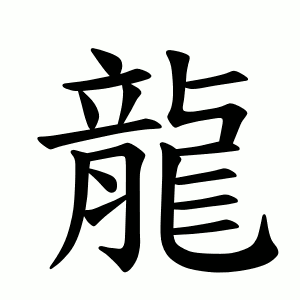Radical 212
Chinese character radical From Wikipedia, the free encyclopedia
Radical 212, 龍, 龙, or 竜 meaning "dragon", is one of the two of the 214 Kangxi radicals that are composed of 16 strokes. The character arose as a stylized drawing of a Chinese dragon,[a] and refers to a version of the dragon in each East Asian culture:
- Chinese dragon, Lóng in Chinese
- Japanese dragon, Ryū or Tatsu in Japanese
- Korean dragon, Ryong or Yong in Korean
- Vietnamese dragon, Rồng in Vietnamese or Long in Sino-Vietnamese
| 龍 | ||
|---|---|---|
| ||
| 龍 (U+9F8D) "dragon" | ||
| Pronunciations | ||
| Pinyin: | lóng | |
| Bopomofo: | ㄌㄨㄥˊ | |
| Wade–Giles: | lung2 | |
| Cantonese Yale: | lung4 | |
| Jyutping: | lung4 | |
| Japanese Kana: | リョー ・リュー ryō, ryū たつ tatsu | |
| Sino-Korean: | 룡 ryong | |
| Names | ||
| Japanese name(s): | 竜 ryū | |
| Hangul: | 용 yong | |
| Stroke order animation | ||
 | ||

It may also refer to the Dragon as it appears in the Chinese zodiac. It is also a common surname.
In the Kangxi Dictionary 14 characters (out of 40,000) are under this radical.
It occurs as a phonetic complement in some fairly common Chinese characters, for example 聾 = "deaf", which is composed of 龍 "dragon" and the "ear" 耳 radical, "a word with meaning related to ears and pronounced similarly to 龍": "dragon gives sound, ear gives meaning".
Characters with Radical 212
Literature
- Fazzioli, Edoardo (1987). Chinese calligraphy : from pictograph to ideogram : the history of 214 essential Chinese/Japanese characters. calligraphy by Rebecca Hon Ko. New York: Abbeville Press. ISBN 0-89659-774-1.
- Leyi Li: “Tracing the Roots of Chinese Characters: 500 Cases”. Beijing 1993, ISBN 978-7-5619-0204-2
Notes
External links
Look up 龍 in Wiktionary, the free dictionary.
Wikimedia Commons has media related to Radical 212.
Wikiwand - on
Seamless Wikipedia browsing. On steroids.
